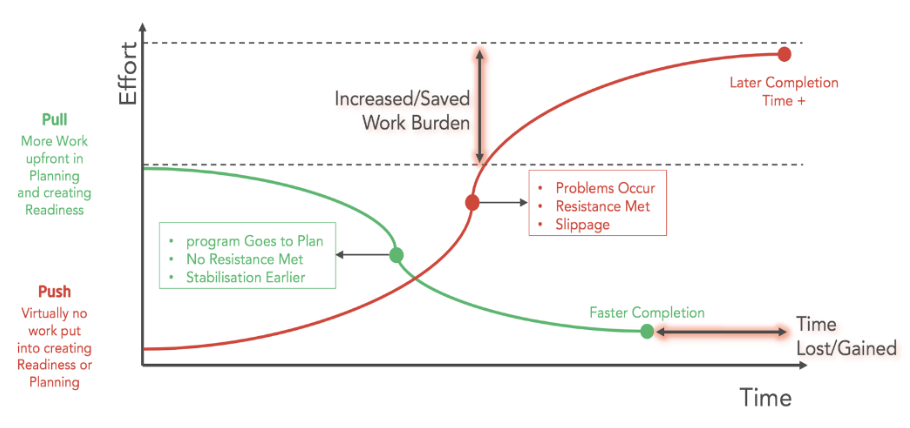“Not all change is created equal.” That’s why ON THE MARK’s approach to change puts collaboration at the core of their solution. This results in the delivery of highly sustainable change management of any business or organization achieving positive business and social outcomes and faster return-on-investment (ROI). business transformation
Leaders, take note — if you’re considering a major transformation in your business, keep reading.
A Sustainable Approach To Business Transformation
“People support what they help create” is part of the secret sauce that makes OTM’s approach to sustainable change management most effective. That’s why all of their work is done collaboratively, which is fundamental to making any change sustainable. And this occurs regardless of the drivers behind or solutions associated with successful business transformation. Whether it’s an implementation of a new IT solution, insertion of a new operating model or post-M/A integration.

But wait — there’s more.
OTM’s collaborative approach (Pull) not only takes significantly less effort than traditional, top-down, expert-driven approaches to change (Push) but also achieves quicker, smoother implementations along with a faster ROI. Now are you listening?
When leaders decide to implement a business transformation, they often make the wrong decisions for the wrong reasons:
- Default to an expert-driven approach to develop and implement
- Look to traditional “Change Management” to manage the change. A remedial, reactive approach with emphasis on communication and training
- Delegate responsibility to others to see the change through to completion
- Confuse installation of the change with behavior change.
Herein lies the problem: Leaders are paid to be decisive and to make big strategic and investment decisions. But when it comes to real transformation, they default to what they know. Rarely, if ever, do leaders ask themselves these questions: “Do we want the change to be a sustainable organization? How important is it to achieve a faster ROI? Do we want to truly engage our people?”
One of the basic premises of a sustainable business transformation is: “What needs to be done is no less important than how it needs to be done.” Keep in mind that the sustainability for change lies in the social system (your people!), not in the solution itself. If your people don’t invest the sweat equity into understanding the problem and co-crafting the solution, then it rarely results in sustainable change management. It’s just someone telling another what to do in absence of the proper context. This is commonly called compliance-based change (push). Compliance as an approach leads to reluctance, resistance and disengagement — what OTM calls a pay-more-later strategy.
Tapping Into Puzzle Learning, Diversity & Collective Genius
Most leaders have a view of what the problem is and what to do about it. They almost never have a complete view. It’s a rare leader who recognizes his/her limited view of the world who then taps into the collective wisdom of the wider business to realize a more complete understanding of the challenge yielding a more robust and always better solution. Proven research and results have shown time and again that diverse groups problem-solve more effectively, make far better decisions and develop more robust solutions because of the diverse views in play and the fact that no one person ever has all of the information.
For ON THE MARK, the collaborative process means that leaders lead by setting the direction, parameters and constraints. Then, they support internal cross-functional, diverse design teams to apply their collective genius to identify the issues before solving them. When this happens, those teams who toiled to develop the solution become very eager to begin implementing. OTM calls this “pull.”
Too many large consulting firms carry out faux collaborative work — work that involves one-way brainstorming sessions, followed by some PowerPoint slides and an already-determined solution. It’s the equivalent of mental download. Then, some experts in some dark corner develop some already-determined solution. And this approach has significant negative consequences.
Compliance vs. Commitment or Push vs. Pull
The question leaders must ask themselves from the start is, “What are you trying to drive in your business transformation efforts — compliance, or commitment?” Leaders must make that decision. They’re paid to make these important decisions, too. One OTM Wisdom is “pay now vs. pay later.”
Pay Now. In a “pay now” scenario, leaders charter diverse teams to collaboratively understand the challenges, issues and aspirations to then craft the right solution. Pay now refers to the time and effort upfront. But the payoff for that investment comes when it is time to implement. Everyone remains committed to the solution they have designed and the implementation runs smoothly, embeds quickly, and is sustainable. It’s enacting a “pull strategy.”
Pay Later. A “push strategy,” or what OTM refers to as “pay later,” encompasses a compliance-based approach to change. Someone, an expert perhaps, comes up with a solution in isolation from those responsible for having to implement the solution and live it day-to-day. This is followed by being ‘change managed’ into compliance to ensure adherence. This approach is fast up front, but is extremely slow to embed, fraught with starts and stops and is rarely sustainable. What was once an achievable ROI gets dragged out for months and years, and even sometimes never gets realized.

The commitment or “pull” solution (“pay now”) is slower up front, but faster at implementation. A pull strategy easily achieves 25% less of a burden and an effort over a “push” strategy — which ends up taking way more time and effort for people to comply and not revert to legacy behaviors.
A leader must consider the cost of compliance against the cost of collaboration. Taking a moderate time view, it makes much more commercial sense to leverage collaboration via a pull strategy into your business transformation strategy.
Now You Have a Choice
One consulting approach relies on The Expert. Let’s say a business is gaining more dissatisfied customers — so they summon a so-called “expert” who forms an opinion of what must be done. Then, everyone must do it because the “expert” says so. Not because that’s what the leaders want to do or because they have decided on it.
Another consulting model is the Doctor-Patient. Leaders bring an expert in, who then talks to the “patient” to try to inquire about what might be going wrong. Next, the doctor comes in with a proposal based on small bits of information from the “patient.” It’s then up to the patient to implement. Nine times out of ten, the patient looks for a new diagnosis or doesn’t follow through on the doctor’s orders.
The OTM Approach to Business Transformation: Through A Collaborative Lens
What we do at OTM is completely the opposite. We never make decisions the business should be making for itself. At the outset, our team at ON THE MARK also never brings any recommendations on what you should do; rather, we bring recommendations on how you should do it collaboratively. When we go into a business, we say to leaders, “Let’s use a methodology or framework within which you can make quality decisions.”
Why does this work? Because the business with all its employees almost always have all pertinent and relevant information needed to solve the challenges. We call this collective genius. We
are experts at helping your people access the veins of knowledge and wisdom to develop the best options, and then letting them make the right decision for the business. This resembles a business-owner mentality. As a leader, you remain involved throughout the process, shape and approve all decisions with your people. Think about it — once the business transformation becomes real, you and your people have decided that. Not some consulting firm or expert.
Imagine what that does for engagement of your employees. The approach produces real engagement – both head and heart engagement. It boils down to the compliance/commitment continuum. Do you want commitment and sustainability, or do you want compliance and the consequences that come with it?
If you’re in the process of deciding about a transformation to your business, thinking about the sustainability of the change is one decision most leaders never make — but need to. Contact us to learn how you can use collaboration to design and implement a sustainable transformation in your business or sign up for our digest to receive monthly updates on the world or organization design.
Peter Turgoose, Senior Consultant, and Mark LaScola, Managing Principal at ON THE MARK. OTM is the leading global boutique organization design consultancy with offices in the USA and UK. With over 400 successful redesigns and operating model modernizations completed, OTM is owner of the industry’s most integrated, comprehensive and holistic organization design solution. OTM enables its clients to realize their future ambitions.
For more information about OTM, what we can do for your business, careers, case studies and more, contact us.


